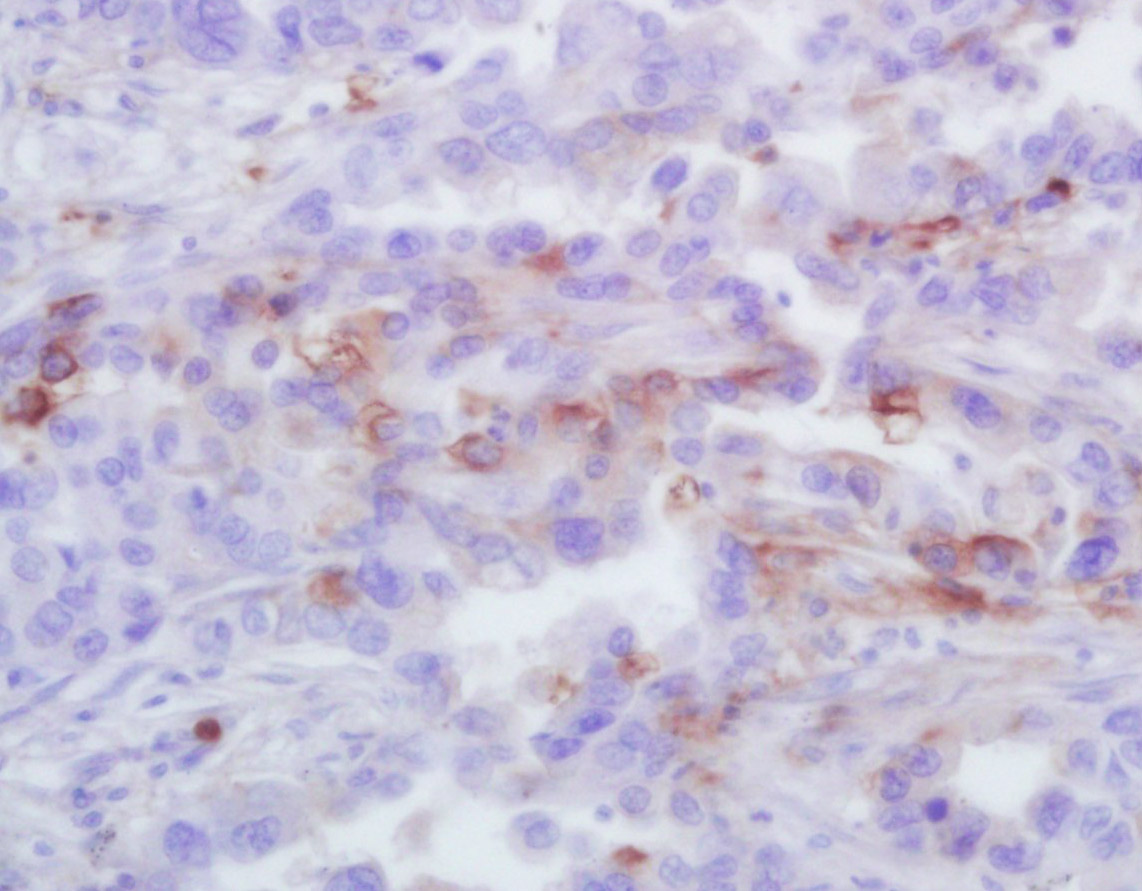GRO Alpha Rabbit pAb
GRO Alpha Rabbit pAb
- 产品详情
- 实验流程
- 背景知识
Application
| IHC-P, IHC-F, IF |
|---|---|
| Primary Accession | P12850 |
| Reactivity | Human |
| Predicted | Mouse, Rat |
| Host | Rabbit |
| Clonality | Polyclonal |
| Calculated MW | 10254 Da |
| Physical State | Liquid |
| Immunogen | KLH conjugated synthetic peptide derived from mouse GRO Alpha |
| Epitope Specificity | 51-107/107 |
| Purity | affinity purified by Protein A |
| Buffer | 0.01M TBS (pH7.4) with 1% BSA, 0.02% Proclin300 and 50% Glycerol. |
| SUBCELLULAR LOCATION | Secreted. |
| SIMILARITY | Belongs to the intercrine alpha (chemokine CxC) family. |
| Post-translational modifications | N-terminal processed forms GRO-alpha(4-73), GRO-alpha(5-73) and GRO-alpha(6-73) are produced by proteolytic cleavage after secretion from peripheral blood monocytes. |
| Important Note | This product as supplied is intended for research use only, not for use in human, therapeutic or diagnostic applications. |
| Background Descriptions | The GRO gene was originally identified by subtractive hybridization studies between normal and tumorigenic Chinese hamster embryo fibroblasts. The hamster cDNA was cloned and used as a probe for cloning of the human GRO cDNA. The GROalpha gene initially cloned from T24 cells and the gene in melanoma cells encoding melanoma growth stimulating protein (MGSA) are identical. Human cells contain three closely related, but distinct GRO genes: GRO alpha, GRO beta, and GRO gamma. GRO beta and GRO gamma share 93% and 82% identity, respectively, with GRO alpha at the nucleotide level. GROs are members of the chemokine alpha family that is characterized by the separation with one amino acid of the first two cysteine residues, C-X-C, in the amino acid sequence. The GRO gene has been mapped to chromosome 4q21. In normal cells, human mRNA GRO expression is found in foreskin fibroblasts, synovial fibroblasts, chondrocytes and osteocytes. Additionally, GRO mRNA has been detected in mammary fibroblasts, mammary epithelial cells, endothelial cells, activated monocytes, macrophages, and neutrophils. Characterization of the GROalpha receptor indicates the presence of low and high affinity receptors on human neutrophils. |
| Gene ID | 14825 |
|---|---|
| Other Names | Growth-regulated alpha protein, C-X-C motif chemokine 1, Platelet-derived growth factor-inducible protein KC, Secretory protein N51, KC(5-72), Hematopoietic synergistic factor, HSF, KC-T, Cxcl1, Gro, Gro1, Mgsa, Scyb1 |
| Dilution | IHC-P=1:100-500,IHC-F=1:100-500,IF=1:100-500 |
| Storage | Store at -20 °C for one year. Avoid repeated freeze/thaw cycles. When reconstituted in sterile pH 7.4 0.01M PBS or diluent of antibody the antibody is stable for at least two weeks at 2-4 °C. |
| Name | Cxcl1 |
|---|---|
| Synonyms | Gro, Gro1, Mgsa, Scyb1 |
| Function | Has chemotactic activity for neutrophils. Contributes to neutrophil activation during inflammation (By similarity). Hematoregulatory chemokine, which, in vitro, suppresses hematopoietic progenitor cell proliferation. KC(5-72) shows a highly enhanced hematopoietic activity. |
| Cellular Location | Secreted. |
For Research Use Only. Not For Use In Diagnostic Procedures.
Provided below are standard protocols that you may find useful for product applications.
BACKGROUND
The GRO gene was originally identified by subtractive hybridization studies between normal and tumorigenic Chinese hamster embryo fibroblasts. The hamster cDNA was cloned and used as a probe for cloning of the human GRO cDNA. The GROalpha gene initially cloned from T24 cells and the gene in melanoma cells encoding melanoma growth stimulating protein (MGSA) are identical. Human cells contain three closely related, but distinct GRO genes: GRO alpha, GRO beta, and GRO gamma. GRO beta and GRO gamma share 93% and 82% identity, respectively, with GRO alpha at the nucleotide level. GROs are members of the chemokine alpha family that is characterized by the separation with one amino acid of the first two cysteine residues, C-X-C, in the amino acid sequence. The GRO gene has been mapped to chromosome 4q21. In normal cells, human mRNA GRO expression is found in foreskin fibroblasts, synovial fibroblasts, chondrocytes and osteocytes. Additionally, GRO mRNA has been detected in mammary fibroblasts, mammary epithelial cells, endothelial cells, activated monocytes, macrophages, and neutrophils. Characterization of the GROalpha receptor indicates the presence of low and high affinity receptors on human neutrophils.
REFERENCES
Anisowicz A.,et al.Proc. Natl. Acad. Sci. U.S.A. 84:7188-7192(1987).
Richmond A.,et al.EMBO J. 7:2025-2033(1988).
Baker N.E.,et al.Nucleic Acids Res. 18:6453-6453(1990).
Kalnine N.,et al.Submitted (MAY-2003) to the EMBL/GenBank/DDBJ databases.
Wuyts A.,et al.Eur. J. Biochem. 260:421-429(1999).
终于等到您。ABCEPTA(百远生物)抗体产品。
点击下方“我要评价 ”按钮提交您的反馈信息,您的反馈和评价是我们最宝贵的财富之一,
我们将在1-3个工作日内处理您的反馈信息。
如有疑问,联系:0512-88856768 tech-china@abcepta.com.























 癌症的基本特征包括细胞增殖、血管生成、迁移、凋亡逃避机制和细胞永生等。找到癌症发生过程中这些通路的关键标记物和对应的抗体用于检测至关重要。
癌症的基本特征包括细胞增殖、血管生成、迁移、凋亡逃避机制和细胞永生等。找到癌症发生过程中这些通路的关键标记物和对应的抗体用于检测至关重要。 为您推荐一个泛素化位点预测神器——泛素化分析工具,可以为您的蛋白的泛素化位点作出预测和评分。
为您推荐一个泛素化位点预测神器——泛素化分析工具,可以为您的蛋白的泛素化位点作出预测和评分。 细胞自噬受体图形绘图工具为你的蛋白的细胞受体结合位点作出预测和评分,识别结合到自噬通路中的蛋白是非常重要的,便于让我们理解自噬在正常生理、病理过程中的作用,如发育、细胞分化、神经退化性疾病、压力条件下、感染和癌症。
细胞自噬受体图形绘图工具为你的蛋白的细胞受体结合位点作出预测和评分,识别结合到自噬通路中的蛋白是非常重要的,便于让我们理解自噬在正常生理、病理过程中的作用,如发育、细胞分化、神经退化性疾病、压力条件下、感染和癌症。






